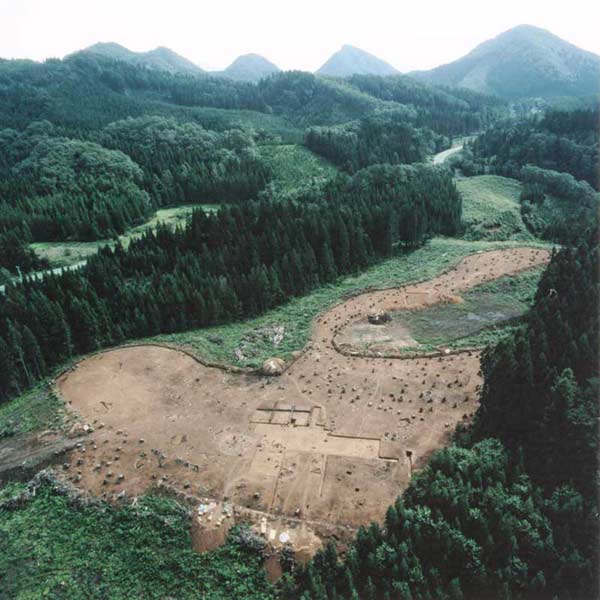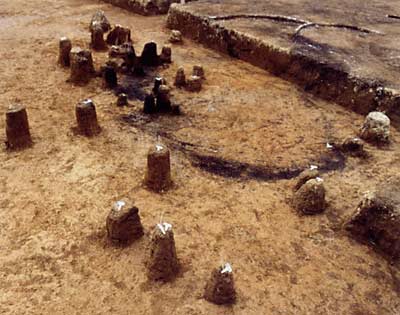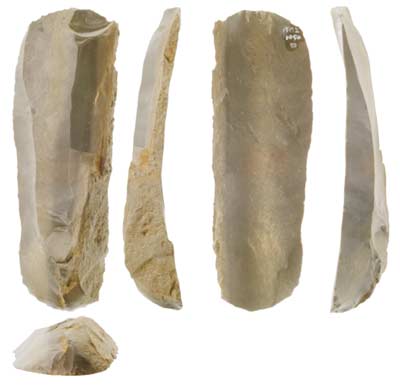Tarō
Mizuno No. 2:
Only completed stone tools are found. A
Paleolithic camp site?

Panorama, Tarō Mizuno No. 2 Site (from the north) The area excavated one level down, at bottom center of the photo, is where the stone tools were recovered. They were found in a limited zone about 40 m square.

Backed blade A backed blade is one in which part of the sharp perimeter of the blade is left as the working edge of the tool, and the remaining portions are blunted. When wear marks were analyzed, this type of tool was found to have been used to butcher meat and hide. Length: 14.7 cm; width: 2.3 cm. |

Stone tools in situ (from the east) Stone tools as they were found. They were recovered from red earth about 40-50 cm below the ground surface. Little difference is seen in their relative depths, and all came from the same layer. |

Scraper Upper Paleolithic, approx. 20,000 BP. Length: 9.8 cm; width: 3.4 cm; thickness: 1.7 cm. |

Backed blade Upper Paleolithic, approx. 20,000 BP. Length: 9.1 cm; width: 2.1 cm; thickness: 0.9 cm. Made from siliceous shale (as are the items to the left and below). |

Burin-shaped stone tool Upper Paleolithic, approx. 20,000 BP. Length: 7.5 cm; width: 3.9 cm; thickness: 1.4 cm. The tool is named for its cutting edge, shaped like an engraver’s burin. It is said to have been used for cutting hard materials and for chiseling. |

Stone blade Upper Paleolithic, approx. 20,000 BP. Length: 11.7 cm;
width: 3.9 cm; thickness: 1.1 cm. |
Photos courtesy of Yamagata Prefectural Center for Archaeological Research.
Tarō Mizuno No. 2 Site, Kaneyama Town, Yamagata Prefecture
A site spreading over a ridge
Tarō Mizuno No. 2 is an Upper Paleolithic (approximately 20,000 BP) site facing the Mamuro river, a tributary of the Sake river in the Mogami river system in the northeastern part of Yamagata prefecture. The Mamuro river has gone through a series of upheavals and periods of severe erosion, leaving the T-shaped ridge where the site is located.
In conjunction with construction to upgrade the Shunezaka highway (national Route 13), a rescue excavation was conducted in 2004 in which 30 backed blades, 1 projectile point, 7 burin-shaped tools, 1 gouge, 1 burin-shaped tool flake, 19 scrapers, 51 blades, 1 flake, and 1 micro flake were recovered, for a total of 112 items.
The stone tools were recovered from a single layer, in scattered fashion over a relatively limited zone about 40 m square. This strengthens the inference that these stone tools were left at this spot at roughly the same time, over a brief interval.
From their characteristics, the recovered backed blades are of the type called Higashiyama. It was not possible to obtain a definite date on the basis of volcanic ash analysis. The Higashiyama type backed blade is known to have appeared approximately 20,000 years ago, but there is no basis for determining the age of the stone tool assemblage from the Tarō Mizuno No. 2 site. From comparison with tools at similar sites, however, it is inferred to be possibly 20,000 years old.
An Paleolithic campsite
To date 135 sites from the Paleolithic period have been verified in Yamagata prefecture, and approximately 50 sites have been excavated. Sources of siliceous shale, suitable for stone tool making, are plentiful in the Mogami river basin, and traces of intensive tool manufacture can be discerned at these source sites. But no signs can be found at Tarō Mizuno No. 2 of the flaking of blades from natural rock to use as the basic material for tools, or of the processing of such items, and it appears that all of the stone tools were brought to the site as completed articles.
When the stone tools were analyzed for traces of use, wear marks from butchering meat and hide were observed on the backed blades and a portion of the stone blades, and those from dressing leather on the scrapers. It is highly likely that Paleolithic man processed game at this location. This kind of site, where previously manufactured tools were simply utilized, is a type previously unknown for a stone material source region. This shows us once again the diversity of activities at sites left by Paleolithic man.
(Saitō Ken)